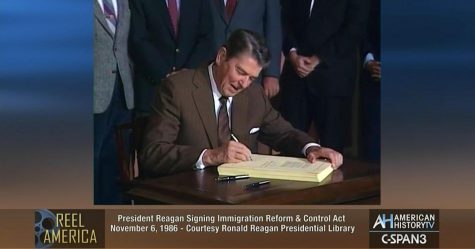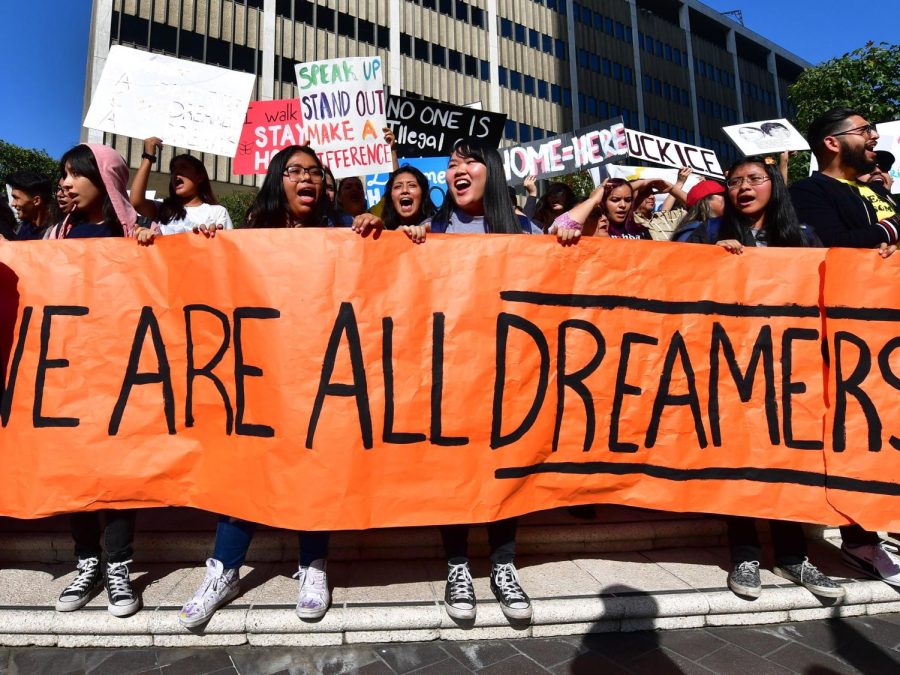From nativism to DACA: a brief history of immigration policy in America
How did American immigration policy become so complicated? And where do we go from here?
October 13, 2021
Earlier this year marked the 100th anniversary of the Emergency Quota Act, the first immigration law in the United States to have established numerical limits on the number of immigrants who could enter the country. In John Higman’s “Strangers in Land: Patterns of American Nativism,” Higman defines nativism as a defensive type of nationalism, and states that the Emergency Quota Act is “the most important turning-point in American immigration policy.” By defining nativism as a “state of mind” in American society from 1860 to 1925, the United States was founded on the set of attitudes of the nativist, because it began regulating immigration soon after it won independence from Great Britain.
Throughout history, immigration has played an important role in the development of countries. It especially continues in the United States, which has the most open immigration policy in the world, according to the Center for Immigration Studies (CIS). The first law to specify who could become a citizen was the Nationality Act of 1790, “limiting the privilege to free whites of ‘good moral character’ who had lived in the US for at least two years” says D’Vera Cohn, senior writer/editor of the Pew Research Center.
During the 1800s, America encouraged relatively open immigration. After some states passed their own immigration laws following the Civil War, in 1876, the Supreme Court mandated for the regulation of immigration to be a federal responsibility. Legislation in 1891 and 1895 created the Bureau of Immigration.
From 1900 to 1920, approximately 24 million immigrants arrived during what is known as the “Great Wave.” World War I reduced immigration from Europe; however, it continued upon the war’s conclusion, and Congress responded with a new immigration policy: the national-origins quota system, passed in 1921 and revised in 1924.
“Immigration was limited by assigning each nationality a quota based on its representation in past U.S. census figures” on the report of the CIS. “There was very little immigration over the next 20 years, with net immigration actually dropping below zero for several years during the Depression. Immigration remained relatively low during the 20 years following World War II, because the 1920s national-origins system remained in place after Congress re-codified and combined all previous immigration and naturalization law into the Immigration and Nationality Act of 1952.”
Long-established immigration restrictions could no longer withstand by 1943, when a law allowed a limited number of Chinese people to immigrate. In 1952, legislation allowed a limited number of visas for other Asians, and race was formally removed as grounds for exclusion. Although a presidential commission recommended abandoning the national-origins quota system, Congress did not comply.
In 1965, a new system was created favoring family reunification, and skilled immigrants, rather than country quotas. This law was the Immigration and Nationality Act, which also imposed the first limits on immigration from the Western Hemisphere. Earlier on, Latin Americans had been allowed to enter the U.S. without many restrictions. “Since enactment of the 1965 Immigration and Nationality Act, immigration has been dominated by people born in Asia and Latin America, rather than Europe” according to the Pew Research Center. Refugees fleeing war violence in the 1970s took refuge in the United States. In 1986, Congress enacted the Immigration Reform and Control Act “[which] granted legalization to millions of unauthorized immigrants, mainly from Latin America who met certain conditions.” The law also “prohibited employers from hiring unauthorized immigrants.” Because several laws since then have focused on refugees, a 1990 law created temporary protections for immigrants, mainly Central Americans, from deportation to countries facing natural disasters or armed conflicts.

The attack on the Twin Towers on September 11, 2001, left a tremendous impact on the public’s opinion of immigration. Twenty terrorists were implicated, 19 of whom participated in the attack that caused 2,974 civilian deaths. “The attack exposed long-standing holes in our immigration system that included failures at visa processing, internal enforcement, and information sharing” says the CIS. “In December of 2005, the House passed the Border Protection, Anti-terrorism, and Illegal Immigration Control Act of 2005, which was sponsored by Rep. James Sensenbrenner (R-WI). The act was limited to enforcement and focused on both the border and the interior.” These measures pressured border control, prioritized enforcement of laws on hiring immigrants, and tightened admissions eligibility.
In August 2012, President Barack Obama announced an executive order entitled Deferred Action for Childhood Arrivals (DACA), which resulted in two-year renewable grants of protection from deportation for approximately 700,000 illegal immigrants who arrived in the country as children.
In 2013, a bipartisan group of eight representatives known as the “Gang of Eight” drafted the Border Security, Economic Opportunity, and Immigration Modernization Act of 2013, which would have provided eligibility for citizenship for the 11 million illegal immigrants, including the DACA recipients. The bill pursued to drastically increase the size of visa programs, “including lifting the high-skilled H-1B visa cap from 65,000 to as high as 180,000 per year, depending upon demand, and creating a new W-visa for an additional 200,000 low-skilled workers. In exchange, the bill promised increased border security and mandatory E-Verify for all employers. Despite passing the Senate 68-32, the bill saw significant grassroots resistance, was not considered by the House, and died in the 113th Congress” as stated by the CIS.
In the 2016 presidential election, President Donald Trump made a wide range of promises regarding immigration during his campaign. Among these promises, he vowed to build a border wall and make Mexico pay for it, deport all illegal immigrants, defund sanctuary cities, ban Muslims from entering the United States, limit legal immigration and triple the number of ICE agents. After the inauguration, he signed several executive orders. “He signed a travel ban which restricted admission of the citizens of what was ultimately seven countries—Libya, Iran, Somalia, Syria, Yemen, North Korea and Venezuela (Chad was included in the final executive order but removed from the list the following year), banning over 135 million potential immigrants and nonimmigrant visitors. Trump also rescinded the DAPA order in June. Lastly, in September, he announced plans to phase out DACA, making potential recipients eligible for deportation.” However, the CIS reported that this backfired. The fate of DACA now remains uncertain.
In January 2021, President Biden announced the US Citizenship Act of 2021 to modernize the US immigration system. If passed, the bill would create the largest legalization program in the United States’ history. Approximately 11 million undocumented immigrants would be eligible for Lawful Prospective Immigrant (LPI) status primarily if they were physically in the US on or before January 1, 2021. Immigrants would be granted work authorization, social security cards, and the right to travel outside of the United States and be readmitted. Immigrants cannot travel outside of the US for more than 180 days though.
“Although President Biden’s immigration proposal was introduced to Congress on the first day of his presidency, it likely will face a long road ahead. The proposed bill has been met with some early criticism, but the president and his allies hope to find common ground and move the legislation forward” reported The National Law Review. I agree with this statement, as every citizen in the United States can’t be in contempt of this policy for many reasons. However, I believe that it’s important for students to be educated about the history of immigration laws and the policies supporting them. In a day and age where our generation’s opinion is respected and we still experience hate crimes against immigrants, we must take advantage of the position we are in. We control the future of immigration as we know it and should not forget that.
After all, I would not have been born in the US without these laws.







